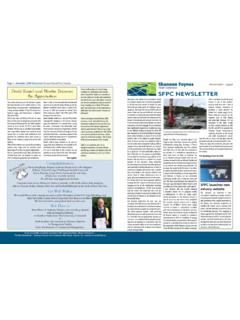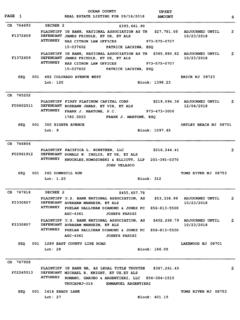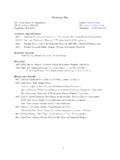Transcription of ”There’s Something Wrong With Our Bloody Fish Today ...
1 There's Something Wrong With Our Bloody Fish Today . Wargaming the cod wars . By David Manley Mention the phrase Cod War+ in a British chippie these days and you'll probably be met with blank stares, but in the mid 1970s everyone who enjoyed a bit of Cod wrapped in newspaper and served up with a pile of greasy chips was glued to events in the North Atlantic. In 1976 Britain went to war for the third time against Iceland over the issue of fishing rights and economic control of the sea. Night after night viewers of the BBC. and ITV news programmes saw footage of RN frigates battling it out with the small, stocky and well built gunboats of the Icelandic Coast Guard. Eventually, as in the previous two wars a diplomatic solution was found which suited some parties on both sides and upset a few others (mostly in Britain and the rest of Europe). However, this is jumping the gun a little, so let's begin with an overview of the cod wars .
2 The First Cod War The first "war" occurred in mid to late 1958. At this time a nation's territorial waters extended a mere 4 miles. British trawlers routinely fished up to the 4 mile limit. In 1958 Iceland unilaterally extended their limit to 12. miles. Iceland depends on its fishing industry more than just about any other country in the world. Iceland has few natural resources, no timber, no fuel, little agricultural potential, and no mineral deposits. As a result her economy is uniquely dependent on fishing for survival and for exports to fund the imports needed for the other parts of the economy, accounting for about 90% of Iceland's total exports in each year between 1881. and 1976. Therefore, it was argued, Iceland had an overwhelming need to ensure the survival of the fish stocks in its area. However, the Icelandic government took the view that foreign fishermen, from the Faroe Islands, Belgium, West Germany and Great Britain were causing an over-exploitation of the fish stocks around Iceland.
3 The tonnage of fish catches had been decreasing since a peak in the 1950's, even though improvements in the design and operation of trawlers allowed greater catches. The size and age of the cod caught had also steadily decreased, so there were fewer cod spawning, again reducing the stocks of cod which decreased by a third during the 1970's. Iceland insisted that catches would have to be reduced in order to preserve cod stocks. As Iceland's economic survival depended on fishing, it argued that other nations should bear the reduction of catches. Great Britain and the other fishing nations had different views. While they agreed that the number of cod had been decreasing, they were not convinced excessive fishing was the cause. Nor did they agree that there should be limits on catches. This position remained essentially unchanged through the three wars . The Second Cod War The second dispute ran from September 1972 to October 1973.
4 This time Iceland extended its fishing limits from 12 to 50 miles. This dispute was concluded with an agreement between the two countries that limited British fishing to certain areas inside the 50-mile limit, and imposed a 130,000 ton limit on the amount of fish that could be caught by British trawlers. This agreement was valid for two years and expired on November 13 1975. The Third Cod War started almost immediately and was the most violent of the three. The Third Cod War The Third Cod War was fought out between November 1975, and June 1976, and threatened to cause a rift in NATO. With the expiry of the 1973 agreement Iceland once again declared an expansion over its area of economic control, from 50 miles to 200 miles. Britain and the other fishing nations of the EEC argued that, whilst the international community was moving towards an agreed 200-mile limit, Iceland had no right to unilaterally enforce the limit.
5 The stage was set for the third, and most lively of the three cod wars , in which the Royal Navy fought to defend the interests of fishermen from several European nations as well as those of Britain. During this conflict, British and other European trawlers had their nets cut by Icelandic Coast Guard vessels and there were numerous ramming attacks between Icelandic ships, trawlers and British frigates. The conflict led Iceland to threaten to close the NATO base at Keflavik, which would have threatened NATO's ability to defend the Atlantic from Soviet attack. The cod wars Article - Amended Page 1 of 10. The conflict lasted for seven months. Iceland employed six Coast Guard ships and two Polish-built stern trawlers, converted for Coast Guard work, to enforce her control over fishing rights. In response, the Royal Navy deployed over 20 frigates, although only between six and nine were deployed at any one time. Britain also employed seven auxiliaries, nine support tugs and three fishery support ships to protect the trawlers.
6 Few shots were fired, and those that were served mainly as warning shots to persuade trawlers to heave to for inspection and probable arrest, or to deter the British escort tugs from interfering with the business of the Coastguard. Several ships were rammed during the conflict and damage was inflicted, some of it quite serious (HMS Diomede was rammed several times by the ICGV Baldur, whilst the Icelandic gunboat Arvakur was cornered and beaten up by trawlers and ocean going tugs operating in support of the British trawler fleets). However, very few injuries were sustained and there was only one accidental death, on the Coast Guard vessel Aegir, when an Icelandic engineer, holding a welding torch which he had just been using for repairs, was electrocuted when a wave came inboard; despite medical assistance he died of his injuries. Despite the accidental nature of the incident the Icelandic government blamed the British for causing the wave that killed the engineer (despite no British ships being close to the Aegir at the time).
7 After a particularly violent period in 1976, the conflict came to the attention of the UN Security Council, but no action was taken. The Nordic Council issued a statement of support for Iceland. NATO, and the USA, became involved, due to the threatened closure of the NATO base at Keflavik. The US offered to mediate, but it was NATO intercession coupled with Britain's eventual acceptance of the 200-mile limit (which incidentally served to set the scene for Britain's oil boom of the 1980s) that helped to end the conflict. With mediation by the Secretary-General of NATO, Dr. Joseph Luns, Iceland and Great Britain came to an agreement on June 2 1976. This agreement limited the British to 24 trawlers allowed inside the 200-mile limit at any one time. The amount of cod that Great Britain could legally catch was limited to 50,000 tons per year. There were four conservation areas that were completely closed to all British fishing.
8 In addition, Icelandic patrol vessels were allowed to halt and inspect trawlers suspected of violating the agreement. The duration of the agreement was 6 months, after which Britain's rights to fish inside the 200-mile limit ceased completely. The agreement with Iceland caused about 1,500 British fishermen to become unemployed, along with an estimated 7,500 people on shore in supporting industries. Wargaming the Cod War At first sight the cod wars seem to be a rather uninteresting subject for an avid wargamer to pursue. After all, no ships were sunk and no-one was killed in action. However, the wars of the 1970s were Something of a defining moment and for a while held the appeal of the world after all, the plucky Icelandic trawlers were up against the might of the Royal Navy and to the casual viewer it was amazing that the ICGVs were defeating . the RN in the perpetual battle of dodgems that took place on the fishing grounds!
9 Despite the fallacious nature of this view the idea of wargaming a period where the aim is NOT to get anyone hurt whilst achieving one's objectives was one that appealed to me. The project languished until 2000 when Mark Barker ran a naval wargaming day at the Royal Navy Museum. I helped out by encouraging NWS. members to put on games from different periods, but drew the short straw in that I opted to contribute a modern game. This seemed like the ideal opportunity and, after a series of playtests with the MOD club at Abbey Wood I had developed a set of fast play rules suitable for a participation game. The rest of the article covers the rules and data for the ships concerned. The rules as presented here are pretty much the same as the original rules that first saw the light of day 16 years ago (I'm writing this in 2016) with only a very few changes and clarifications made in the intervening years as a result of playing at clubs and in participation games at shows.
10 I hope you enjoy them The cod wars Article - Amended Page 2 of 10. Cod War - Tactical Rules The rules were written with 1/1200 scale models in mind. Double all distances if 1/600 scale models are used. 1/3000 scale miniatures could be used, but the visual appeal of the larger models will be lost and, after al, the key feature of the events of the cod wars was VERY close manoeuvring! The rules work best if one player controls only a single ship. If the appeal of driving a trawler for the game is limited it is suggested that the RN players control no moir than one warship and one trawler. A typical scenario would include 1 or 2 warships, 2 to 4 trawlers and one or two Icelandic gunboats. There are bother opportunities for scenarios see the end of the rules. The rules suit a table at least 6 feet by 4 feet. If a smaller table is used then I suggest using centimetres instead of inches. All die rolls use one or two 6-sided dice (referred to as d6).







